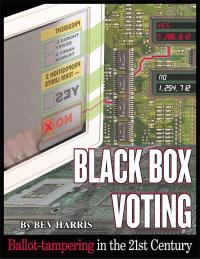Bev Harris: Diebold GA Position Reversed Again
Diebold position reversed (again)
Friday, August 8, 2003
By Bev Harris – blackboxvoting.org
Just got this e-mail from Diebold spokesman Joe Richardson:
FYI... The following article, which originally contained incorrect information regarding software code used in an election, has since been corrected and updated with additional information. A link to the story is provided for your convenience.
At issue: Original story said that Diebold company spokesman Mike Jacobsen “confirmed that the source code Rubin's team examined was last used in November 2002 general elections in Georgia, Maryland and in counties in California and Kansas.”
The new version says: "Diebold spokesmen said the code Rubin downloaded and examined was more than a year old. The code he obtained was "less than 5 percent" of the whole application, they said. In addition, the application Rubin examined "on the whole is not the same" as applications in machines used in elections in places like Georgia and Maryland, said John Kristoff, Diebold's director of communication and investor relations.
Diebold cannot determine whether the lines of code that raised concern for Rubin were used in machines in the field, Kristoff said."
* * * * Well, now is this really such a mystery? The official NASED-certified versions of the Ballot Station programs are: 4.0.11 and 4.3 The version numbers in the code examined by Rubin et. al include: 4.0.11 and 4.3
The records request ( http://www.blackboxvoting.org/ORA-Request-Georgia.pdf) submitted by the Georgia Libertarian Party may put this issue to rest: They asked the state of Georgia to formally state what version was used in its elections. That number can then be compared to the source code.
A word about the phrase "more than a year old": The November 2002 election is, as of this writing, 9 months old. The software put on this system was installed in June and July 2002, with updates in July, August, September and October. Only certified programs can be used. It takes some time to go through certification. It is probably impossible to have used software that is less than a year old in an election held 9 months ago.
A word about the term "on the whole is not the same": The question is, was the BALLOT STATION software examined by Rubin et. al. the same as the BALLOT STATION software used in the election? It is not relevant what machines ran the code, since the evaluation is based on the source code itself, not the machines. In fact, you can read what source code does without ever putting it on any machine.
This is a yes-no question: Was the Ballot Station version used in the election version 4.0.11 or version 4.3 or a different version altogether? Was it certified? This is an easy question to solve: Version numbers are written into the source code. The version number either matches or it doesn't.
Parsing: "[we]cannot determine whether the lines of code that raised concern for Rubin were used in machines..." is absurd. Machines run on a source code package. If Diebold is claiming that there were two sets of source code which both had the same version numbers in them, they should show evidence of that (and explain how that comports with their claim, as stated in the Georgia sales presentation, that they follow ISO 9000 procedures, which would prohibit parallel sets of code with the same version numbers).
Diebold statements
"The code was never used in any election."
About
those patches: "We have no indication that that took
place"
About connectivity: "The machines are
never connected to the Internet"
Bev Harris is author of Black Box Voting:
Ballot Tampering In The 21st Century … See
http://www.blackboxvoting.com/ and it's activist arm
http://www.blackboxvoting.org/ For more
background and live news links on this news subject see also
Scoop's Special Feature – A Very American
Coup…

Pre-Order your copy
of Black Box Voting today…


 Binoy Kampmark: Fallibility, Dirty Wars And Pope Francis I
Binoy Kampmark: Fallibility, Dirty Wars And Pope Francis I Peter Dunne: Dunne's Weekly - An Issue No-one Can Afford To Lose
Peter Dunne: Dunne's Weekly - An Issue No-one Can Afford To Lose Martin LeFevre - Meditations: Choosing Mass Murder?
Martin LeFevre - Meditations: Choosing Mass Murder? Eugene Doyle: Quiet Mutiny - The U.S. Army Falls Apart
Eugene Doyle: Quiet Mutiny - The U.S. Army Falls Apart Gordon Campbell: Papal Picks, And India As A Defence Ally
Gordon Campbell: Papal Picks, And India As A Defence Ally Binoy Kampmark: The Selling Of America - Ending The US Dollar’s Exorbitant Privilege
Binoy Kampmark: The Selling Of America - Ending The US Dollar’s Exorbitant Privilege